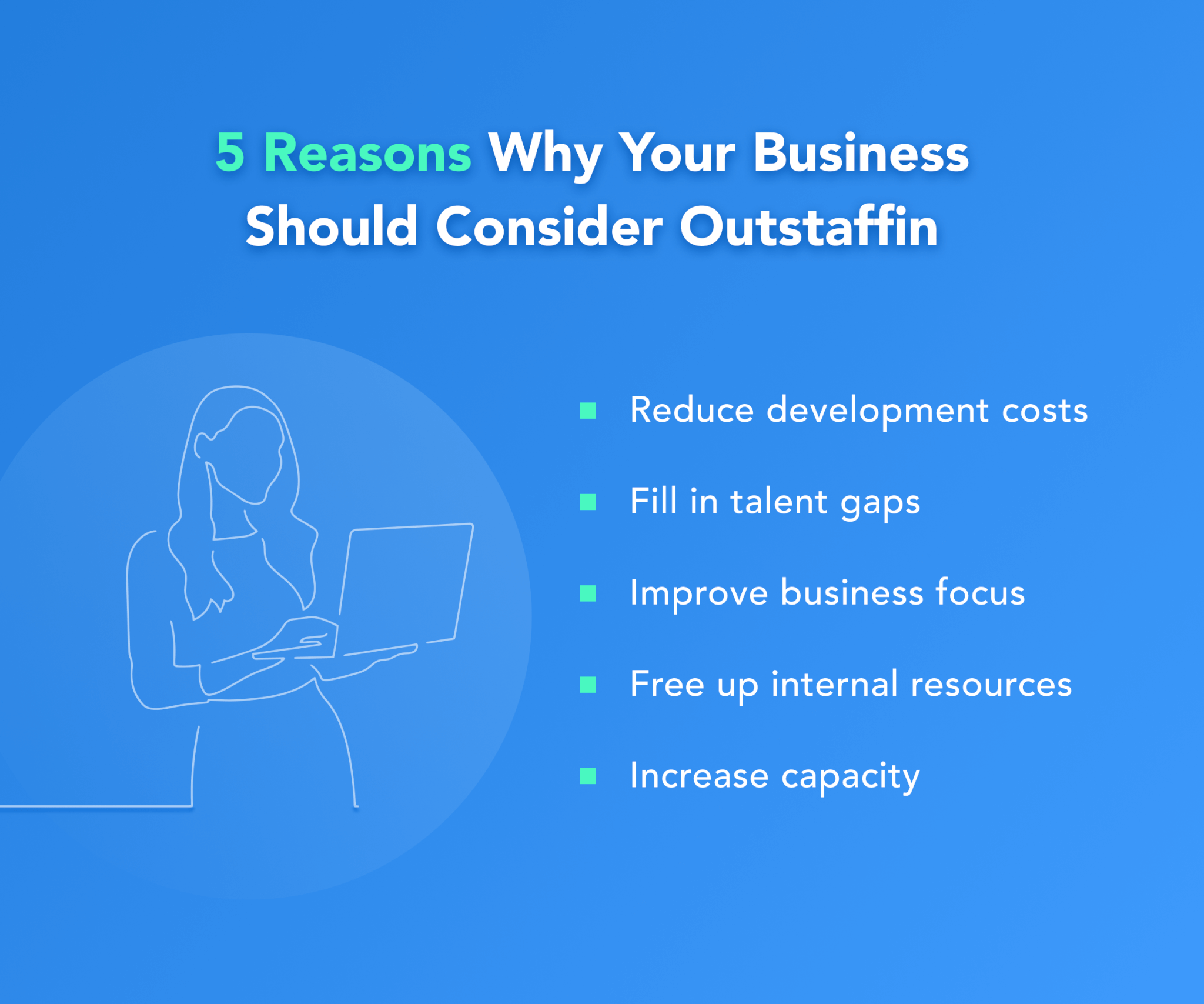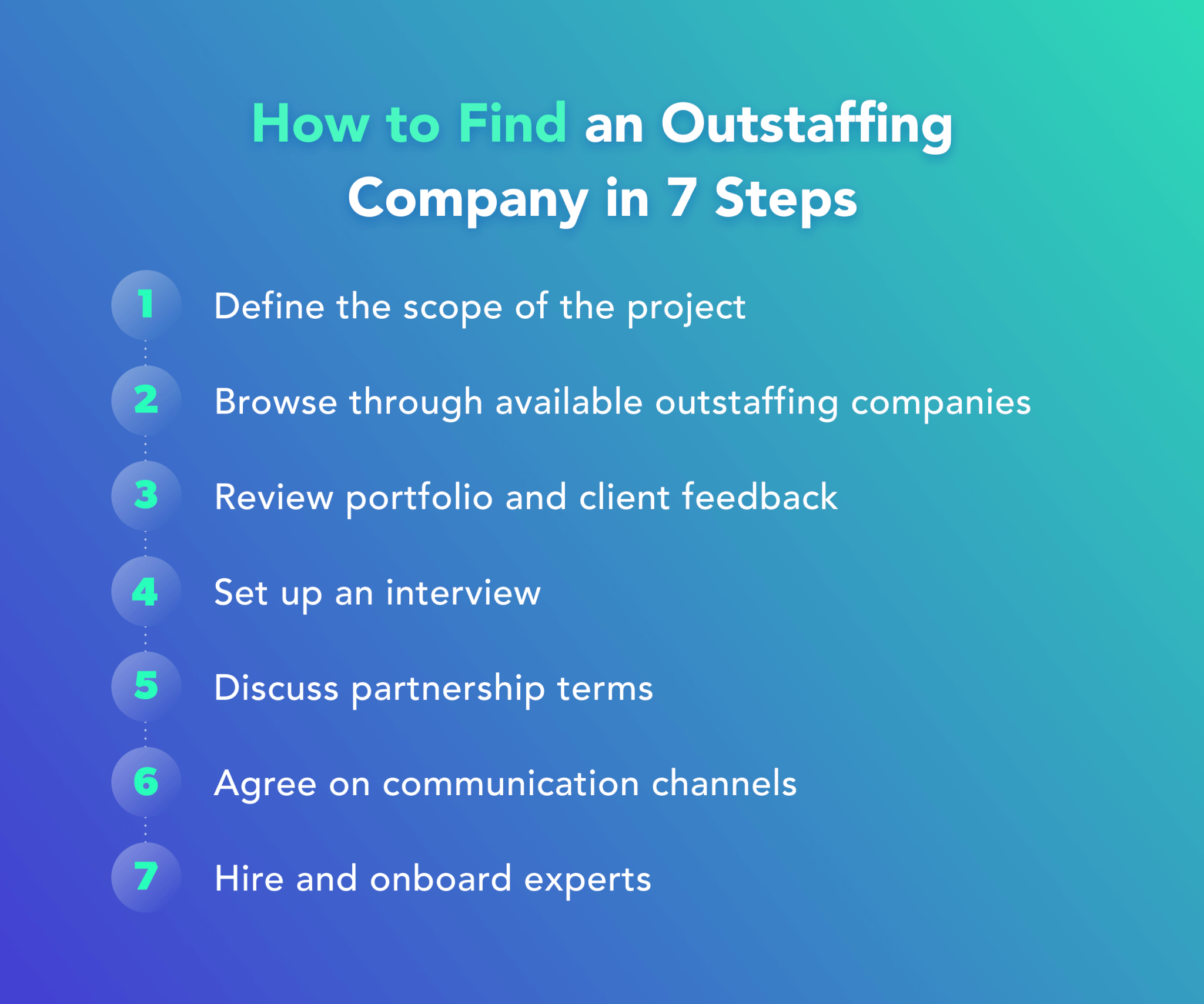Running a successful business means constantly looking for new talent and opportunities. Whereas the latter come and go, sometimes without us being able to control this process, finding the right talent is what we can manage more effectively.
What is the first thing that comes to mind when we want to add new talent to the existing staff? Right, hiring a full-time employee. However, such an expert can be too much for the staffing budget to handle, especially if you’re an aspiring startup. This is where knowing what is outstaffing may become very useful.
It provides businesses with the flexibility to access a vast talent pool and fill missing skill gaps in their team. In addition, outstaffing improves the technical capacity of the project with the help of third-party expertise and ensures that a project is delivered on time.
Statista forecasted that the IT outstaffing revenue would hit US$395.00 billion in 2023, emphasizing the attractiveness of the software outstaffing model.
In this article, we’ll discuss the benefits of outstaffing for business, as well as its pros and cons.
- What is an Outstaffing Model?
- Pros & Cons of Outstaffing
- When to Outstaff?
- Outstaffing Example
- Outsourcing vs Outstaffing: Key Differences Between the Models
- Benefits of Choosing IT Outstaffing
- Can Outstaffing Replace In-House Employees?
- 7 Steps to Finding a Perfect Outstaffing Company
- Why Softengi Could Be the Best Outstaffing Partner for Your Project
What is an Outstaffing Model?
Outstaffing definition is a model of team augmentation that implies hiring external specialists from another software development company to enhance your own team. Most of the time, outstaff specialists are located in other cities, countries, and even continents.
Under this model, a remote employee will be focused entirely on the client’s project long-time. Meanwhile, the service provider will act as the official employer, taking care of paying benefits, bonuses, insurance, taxes, software licenses, as well as all the equipment.

The outstaff specialists will carry on working at their workplaces at the current company. However, they will be fully managed by the customer. It can be seen as leasing, where you can lease the entire team to fit your own development needs. Legal registration of such employees is not required, which makes outstaffing a lucrative team augmentation solution for companies who can’t – or simply don’t want to – afford to hire full-time employees.
Pros & Cons of Outstaffing
The outstaffing model will benefit those companies that wish to obtain dedicated specialists or entire teams, remaining in full control over planning, task distribution, quality assessment, and management in general. It is perfect for startups and companies looking for developers with specific skills to complement their existing teams. Flexibility, supervision of results, and cost-effectiveness are the three pillars of team augmentation with outstaffing.
PROS:
- Affordability. As a customer, you don’t have to create a dedicated workplace, pay taxes or insurance, or hire a project manager.
- Full control. A remote employee will be fully under your control. They won’t be working on any other projects, focusing solely on the tasks you give them. Day-to-day communication, task distribution, and the general success of the project will be in your hands.
- Scalability. It’s possible to outstaff individual developers or entire teams.
- Going global. If there are no suitable specialists in your location or they are too expensive, you can hire specialists from around the world where services are more affordable, but the talent pool offers greater options.
- Convenience. Whereas the outstaffing agency handles all the HR and administrative aspects, you can focus solely on your project without distraction.
CONS:
- Communication. While remote specialists might be working from other countries and in different time zones, it’s important to set up effective interaction between every member of the extended team. It goes without saying that everyone has to speak the same language, e.g., English.
- Additional management. The outstaffing model implies the customer company taking care of management. Personal involvement in every development aspect is required, as are strong managerial and technical skills.
- Data leakage. Working with an outstaff team, you’ll be providing them with access to sensitive corporate information, project documentation, software, etc. When outstaffing employees, taking security measures and drawing up a detailed NDA are highly recommended.

When to Outstaff?
IT outstaffing is a viable solution if you want to expand your team with new employees. Some of the key reasons why companies consider outstaffing usually are:
- Inability to afford additional in-house developers;
- Absence of skilled developers in the client’s location with sought expertise;
- Desire to avoid HR and recruitment routine;
- Focus on the result;
- Pay only for working hours.
Although such “rented” employees will be officially employed with another company and even located in another country, they’ll be working entirely on your project and under the supervision of your management. All the other technical and legal aspects will be handled by the company providing the outstaffing service.
Outstaffing Example
A large industrial manufacturing company in Europe decided to develop a solution that could minimize or prevent serious and fatal injuries during construction. The company felt that using the IoT technology would benefit the project significantly. However, they lacked expertise in this area, which resulted in hiring Softengi experts to fill in the talent gaps. Together with the client’s in-house developers, they’ve been able to create a complex Smart Site Safety Solution (4S) that reduced the risk of on-site accidents by 70%.
Outsourcing vs. Outstaffing: Key Differences Between the Models
There are two ways to augment your development team with an external workforce – outstaffing and outsourcing. We’ve already discussed outstaffing, so let’s briefly review what’s outsourcing.
While the two models are highly in demand with both large tech giants and small startups looking for remote talent, the key difference is that the outsource model enables you to hire external developers to deliver a solution on a turnkey basis. It means that you’ll be fully entrusting the project’s success to a third-party service provider from A to Z. They’ll take care of every stage of the development process, including a team structure, tech stack, frameworks, workflow, etc.
The major downside of outsource vs outstaff is almost a complete lack of control over the development process. As a result, the overall success depends on how well you choose an outsourcing partner and whether they’ll be able to deliver the estimated result. The cost of outsourcing is usually higher than outstaffing.
We’ve prepared this table where you can compare key differences between outstaffing and outsourcing models:

Benefits of Choosing IT Outstaffing
Many businesses have turned to the outstaffing model over the years, and these are their primary motivations.

Reduce Costs
According to research, 24% of small businesses outsource to increase efficiency, whereas 66% of firms in the United States outsource at least one department. It happens that way mainly because skilled and experienced developers in the US are becoming more and more expensive. In the meantime, experts from developing countries with the same skill level charge less.
Fill in Talent Gaps
New technologies emerge fast, making companies consider implementing innovation faster than the competition. However, specialists with the necessary skills are sometimes difficult to find, or they could be too costly. Outstaffing is the quickest way to find the right talent for a reasonable price without tiresome recruitment that could take ages.
Improve Business Focus
Business is about marketing, sales, and pitching to clients, not writing code. There’s no point in trying to figure out new tech trends on your own. Outstaffing lets companies focus on the business side (making money), whereas dedicated specialists take care of what’s under the hood.
Free Internal Resources
Software development requires serious resources. Besides wages, you have to pay for hardware, software licenses, social packages, etc. With outstaffing, an oversea company will be taking care of all the administrative duties, relieving you from any unnecessary bureaucratic commotion.
Increase Capacity
Companies in the growth phase might be facing difficulties with effective staff and infrastructure scaling. Augmenting a team with outstaff specialists is perhaps the fastest and least costly way for a company to upscale.
Can Outstaffing Replace In-House Employees?
Absolutely, outstaffing can operate on a project or a full-time basis where a hired expert will be an all-out member of the extended team under the supervision of management on the client side.
However, there are companies that want people working on their projects to physically be a part of their team. This is impossible with software outsourcing and outstaffing, where the specialists are officially employed by the vendor located in another country or even overseas. Investing in the training of third-party contractors instead of your own employees is also something to think about.
7 Steps to Finding a Perfect Outstaffing Company
If you’ve made up your mind in favor of outstaffing, follow these steps to hire a competent IT outstaffing company.

Step 1 – Define the Scope of the Project
Before reaching out to an IT outstaffing services provider, it’s important to figure out several key questions. First of all, the nature of your business will determine what kind of expertise your future project requires. Secondly, you should determine what experts are lacking in your current team. And thirdly, a rough estimate of how many developers you need would be a perfect grounding to start a discussion with a potential development partner.
Step 2 – Browse Through Available Outstaffing Companies
Possible outstaffing service providers can be found using search engines, business forums, the world of mouth, or specialized platforms like Clutch.
By the way, according to Clutch, Softengi is among the top 1000 B2B service providers and one of the top 15 VR and AR development companies in the world. The Manifest featured Softengi as one of the best IoT developers globally. We thank our clients for the positive feedback and are looking forward to delivering your success.
Step 3 – Review Portfolio and Client Feedback
Running a background check is the first thing you should do to hire a dependable service partner. Clutch is a great platform for checking out legit reviews about outstaff companies globally. Visiting a vendor’s website will also give you an impression of their achievements, years in the business, mission, expertise, etc. Compare companies that you’ve found and make a decision about which one you’ll be contacting.
Step 4 – Set up an Interview
Scheduling an interview with a possible outstaffing partner is pivotal for making a decision on whether a vendor is a good match. Talk to a technical manager and see how their development process is arranged. It’s crucial to know right from the beginning whether they have developers with the exact expertise you want. If experts have already been engaged in projects similar to yours, it would only be a big plus.
Step 5 – Discuss Partnership Terms
If you are satisfied with the choice of developers, you could enter into further discussion of the process, security, liabilities, as well as any other legal details. As these issues are talked through, it would be best to have them in a written form to avoid misunderstandings.
Step 6 – Agree on Communication Channels
Since the outstaffing model implies constant interaction with remote team members, it’s vital to establish an effective communication channel and means of monitoring development progress. For example, Slack for communication and Jira for task tracking. As a universal language of communication between experts located in different countries or even continents, English is usually preferred.
Step 7 – Hire and Onboard Experts
After a formal outstaffing agreement is signed, it’s time to onboard new members of your development unit. Make sure you give them a warm welcome, as well as thorough guidance, project objectives, and milestones to achieve while contributing to your company’s success.
Why Softengi Could Be the Best Outstaffing Partner for Your Project
Softengi has been featured in The Top 100 Global Outsourcing List seven times. The company connects ambitious businesses worldwide with top-tier developers. We help startups, as well as large international companies, continuously grow with the help of IT staff augmentation. This enables companies to focus purely on business and product development, leaving HR management to professionals.

We have successfully fulfilled 1000+ projects and are looking forward to delivering your success. Here are some examples of industries, developed solutions, and results we brought to our clients.
- Logistics
Through more effective warehouse management, Softengi boosted a client’s business efficiency by 34%.
- Digital Twins/VR
After creating a digital twin of deep drilling machine equipment for a German manufacturer, their productivity improved by 46%.
- 3D Visualization
We’ve been able to attract x3 more investors for CIEGNO, a developer of a luxurious resort near Badalucco, Italy, by creating a virtual 3D landscape of the entire complex.
- Computer Vision
The number of documents a European logistics company signed increased x4 with the help of implementing a modern OCR solution.
- AR
Ad conversion of ZERNO, a Ukrainian agricultural magazine, raised by 27% after harnessing AR advertising.
- Marketplace Development
After Softengi helped our clients in retail offer their customers an AR shopping experience, their revenue surpassed the pre-COVID results by 11%.







